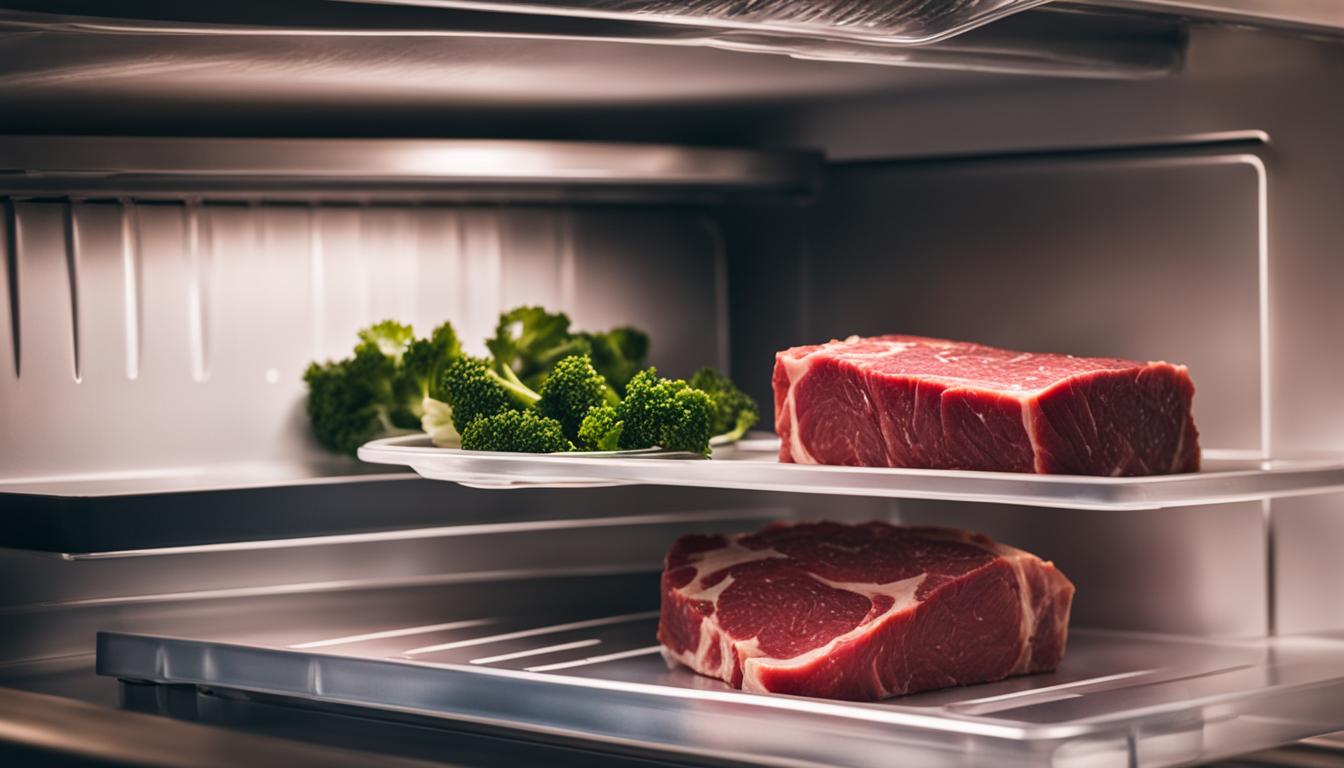As an avid home cook and food safety advocate, I frequently come across questions regarding the proper storage of meats, particularly steaks. A common query looks at the duration steak remains fresh while stored in a refrigerator. The USDA provides clear guidelines on both raw and cooked steak, emphasizing the need for careful meat storage to preserve its quality and extend shelf life.
A raw steak’s lifespan in the fridge is typically limited to 3-5 days to prevent spoilage and maintain safe consumption standards. When it comes to cooked steak, the USDA suggests a marginally shorter period of 3-4 days to enjoy its savory goodness. These time frames, however, can be influenced by how we’re preserving steak, with refrigerator storage conditions playing a pivotal role.
For those wanting to extend these windows, vacuum sealing emerges as a noteworthy method, drastically reducing air exposure and controlling moisture levels, thereby fortifying our meat storage strategies.
Key Takeaways
- Raw steak should be refrigerated no more than 3-5 days, while cooked steak lasts for 3-4 days, as per USDA guidelines.
- Proper meat storage, including vacuum sealing, is integral to preserving steak and preventing bacteria-induced spoilage.
- Refrigerator storage below 40°F is key to keeping steak fresh and extending its shelf life within safe boundaries.
- Packaging plays a crucial role, with vacuum sealing offering a superior option for extending the fridge life of steak.
- Being attentive to the longevity of steak within the fridge is essential for avoiding foodborne illnesses and wasted produce.
Understanding the Shelf Life of Steak
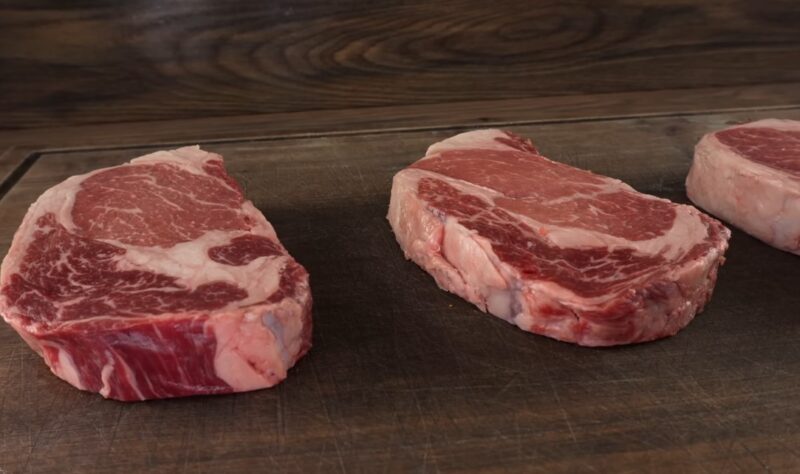
As a meticulous food enthusiast and safety-conscious consumer, I’m well-versed with the various elements that dictate the steak shelf life. Not only does it revolve around how the steak is packaged, but factors such as the freshness when purchased and the specific cut of the steak play pivotal roles too. In my experience, the shelf life of raw steak in the fridge hovers around 3-5 days. This window, confirmed by USDA standards, becomes crucial if you value food safety and wish to enjoy steak at its optimum state.
The scenario changes a tad for cooked steak; its residence in the fridge shortens to about 3-4 days. And let’s not overlook the importance of storage methods. Impeccable food storage techniques can push your steak’s freshness to the far end of these timelines. Wrapping methods that fend off oxygen can fend off meat spoilage too, offering us a tad more leeway with consumption dates.
Let’s take a dive into the details with a comprehensive table outlining the recommended shelf lives based on USDA data and the impact that packaging methods have on them:
| Storage Method | Raw Steak Shelf Life | Cooked Steak Shelf Life |
|---|---|---|
| Vacuum Sealed | Up to 5 days | Up to 4 days |
| Tightly Wrapped in Plastic | 3-5 days | 3-4 days |
| Original Butcher Paper | 3-5 days | 3-4 days |
“Sell by” and “use by” dates are also part of the equation, a nomenclature the USDA doesn’t take lightly. They are not mere suggestions but rather sober reminders set in place to guide us toward the freshest and safest meat consumption period, contributing substantially to quality and freshness assurance. From personal experience, abiding by these dates has been a steadfast method in preventing any unpleasant instances of spoilage.
- “Sell by” Date: This is the date by which the retailer aims to sell the steak but is not an expiration date. Steaks can typically be safely consumed a few days beyond this date if stored properly.
- “Use by” Date: Indicates the last date recommended for the product’s peak quality. It’s a good rule of thumb for assessing fresh steak’s optimal consumption window.
“Understanding and adhering to these timelines is vital to ensuring the steak’s quality remains uncompromised while it sits in your fridge. Moreover, such awareness is key in safeguarding your family from potential spoilage-associated health risks.”
Remember, the cut and initial quality of your steak matters as well. A superior cut from a reputable source may hold its freshness just a tad longer, providing you adhere to the recommended guidelines. Each steak’s journey from the butcher’s block to your table is important and understanding these nuances could be the defining factor between subpar meat and a gastronomic delight.
The Role of Refrigeration in Preserving Freshness

In my continuous quest to ensure preserving steak at its peak freshness, I’ve found that understanding and managing refrigerator temperatures is critical to this process. The delicate balance of cold storage is the barrier between delectable meals and undesired meat spoilage. As I delve into the intricacies of this refrigeration dance, I consistently champion the imperative of keeping our refrigerator settings dialed into the ideal zone for steak storage.
How Temperature Affects Meat Spoilage
The correlation between temperature and the rate of meat spoilage cannot be overstated. The rapid escalation of bacteria within the ‘danger zone’ of 40°F to 140°F is notorious for turning a prime cut of steak into a breeding ground of potential foodborne pathogens. It’s within this range that bacteria flourishes, leading to accelerated spoilage and the jeopardization of both flavor and safety.
Keenly aware of this, I thriftily adjust my own fridge to suppress bacterial growth, ensuring that the refrigerator temperature is consistently at or below 40°F. This practice falls in line with USDA recommendations and is a proactive stance against microbial invasion and subsequent meat spoiling.
Optimal Refrigerator Settings for Steak Storage
Seeking out the perfect refrigerator setting for steak storage is akin to discovering the holy grail for meat preservation. My experiences align with the best practices advocated by food safety experts; maintaining a temperature steadfastly at or below 40°F, which is the number (4 in Celsius) often associated with food safety. It becomes a preventive tactic for meat spoilage, anchoring the freshness of the steak firmly within the safe confines of those crucial 3 to 5 storage days for uncooked cuts.
Here’s the breakdown of the USDA’s time frames for steak stored under optimal fridge settings:
| Condition | Maximum Storage Duration |
|---|---|
| Raw Steak | 3-5 Days |
| Cooked Steak | 3-4 Days |
| Fridge Temperatures At/Below 40°F | Ensures Maximum Storage Duration |
“By maintaining the refrigerator temperature just right, I not only preserve the integral sensibilities of a fresh steak but also stand guard against the adversaries of meat spoilage.”
And so, with these parameters established and the refrigerator properly calibrated, the steaks I store are not merely kept; they are shielded in a frigid sanctuary, awaiting their eventual soaring triumph upon the gastronomic stage. This careful curation of temperature is, indeed, the guardian of their fleshly essence and savor.
Raw Steak in the Fridge ─ USDA Guidelines
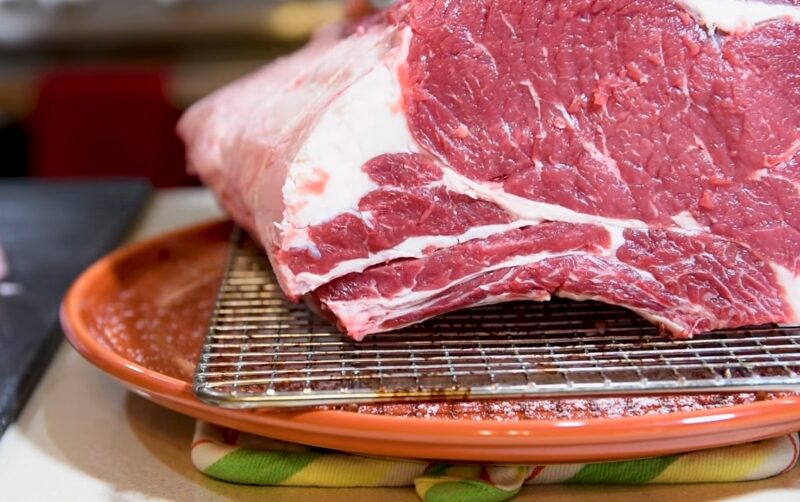
When it comes to storing raw steak in the refrigerator, my adherence to USDA guidelines has always ensured the safety and freshness of my meats. According to these regulations, the optimal conditions for raw steak storage involve keeping your refrigerator at or below 40°F, which is instrumental in hindering the proliferation of spoilage bacteria. Additionally, understanding the significance of “sell by” dates on steak packages helps to monitor and determine peak quality consumption times, reinforcing sound meat storage practices.
How does the home cook ensure that USDA guidelines for steak freshness are met in their kitchens? I’ve crafted a comprehensive table to illustrate the refrigerated life span afforded to steak under the best storage cases:
| Steak Type | USDA Recommended Refrigeration | Temperature Requirement |
|---|---|---|
| Raw Steak | 3-5 Days | At or Below 40°F |
| Cooked Steak | 3-4 Days | At or Below 40°F |
| Impact of “Sell By” Date | Informs retailers when to rotate stock for peak freshness | |
| Advises consumers on the ideal time period to use the steak | ||
Let’s delve deeper into the importance of the refrigerator’s temperature setting, the unsung hero in meat preservation. Keeping your refrigerator’s thermostat set just right not only preserves the sensual qualities of a fresh steak but also acts as a bulwark against potential spoilage. My experience dictates that vigilance in this area pays dividends in maintaining the quality of meat, translating to profoundly satisfying culinary experiences.
I would be remiss if I didn’t stress the role of proper packaging in this process. Often overlooked, choosing the right wrap or container for storing your steak can dramatically fend off the adversities of oxygen exposure and moisture loss, crucial factors that can accelerate meat degradation. That is why diligently wrapping raw steaks and promptly placing them into the refrigerator is not just recommended; it is a rule I live by in my kitchen.
“As someone deeply passionate about the nuances of food safety and storage, following USDA guidelines for raw steak storage is not so much a protocol as it is a promise—a promise to uphold the peak conditions for savoring the ultimate steak experience.”
Ultimately, while the USDA’s guidelines serve as a compass directing us towards methods that prevent spoilage, I’ve discovered that taking these extra steps is what sets the table for a remarkable meat dish that is both exquisite to the palate and kind to our well-being.
Cooked Versus Raw ─ Does it Make a Difference in Longevity?
My culinary journey has consistently reaffirmed that the battle between cooked steak longevity and raw steak longevity is determined by a few crucial factors. Among such considerations is the response of the meat to refrigeration post-cooking, and here, science provides some insights as well. When evaluating steak freshness, contrasting the longevity of cooked versus raw steak uncovers that cooked steak typically has a slightly shorter span within the safe consumption zone—a frame of 3-4 days according to USDA guidelines.
But why does cooked steak have a reduced refrigerator life compared to its raw counterpart? It’s the cooldown process. A freshly cooked steak goes through a period where it gradually moves from hot to cold, potentially hovering through the temperature “danger zone” that accelerates bacterial growth before the steak finally settles into the refrigeration environment.
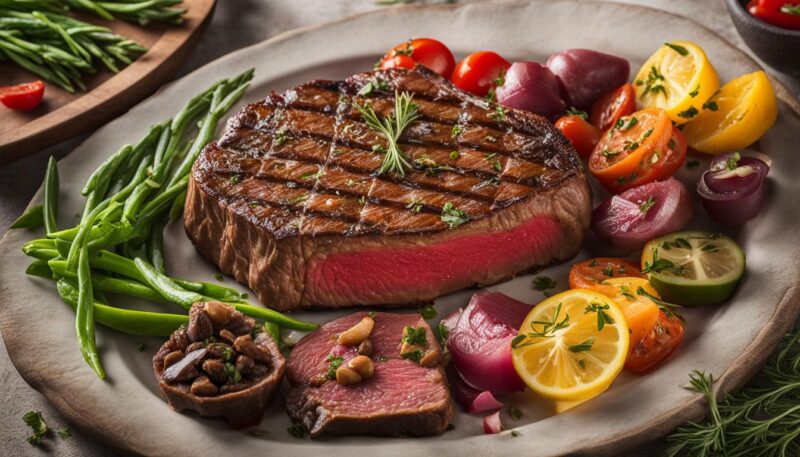
Let’s examine the recommended time frames for both cooked and raw steaks when stored in a refrigerator:
| Steak Condition | Recommended Storage Time in Fridge |
|---|---|
| Raw Steak | 3-5 Days |
| Cooked Steak | 3-4 Days |
The truth herein is that while both cooked and raw steaks boast a commendable shelf life, their storage time is not the same. Ensuring your steak remains out of the “danger zone” during the cooldown phase is pivotal. This can be achieved by allowing the steak to reach room temperature before refrigerating, which minimizes the time spent in temperatures where bacteria are known to proliferate.
“As I meticulously strive for culinary excellence, I’ve learned that preservation involves an intricate dance with temperature—a dance where precision is both an art and a science.”
Moreover, I can’t overemphasize how pivotal it is to seal these steaks promptly, considering oxygen exposure is as detrimental to cooked steaks as it is for raw ones. Although cooked steaks are seasoned with our favorite spices, they’re also seasoned by their environment, and refrigeration that is delayed or executed poorly could very well change their fate from delightful to discardable.
- Understanding that cooked steak requires expedited refrigeration is critical for kitchen connoisseurs.
- Ensuring that the steak cools to room temperature before refrigeration can enhance its longevity.
- Proper storage post-cooking should not be underestimated for maintaining steak freshness.
In closing this section, it’s evident that every steak enthusiast should bear in mind the nuanced differences in longevity between cooked and raw steaks. Considering the integral role these distinctions play, one can appreciate that both forms of steak have their requirements and ideal conditions for retaining the highest level of freshness and edibility.
Vacuum Sealing ─ Extending the Life of Your Steak
As someone committed to the culinary craft, I’ve continuously sought methods for extending steak life and maintaining its freshness. The solution I’ve found most effective is vacuum sealing, a technique that encompasses both art and science to enhance the steak’s shelf life substantially. Vacuum sealing benefits extend well beyond mere storage; they touch upon every aspect of meat preservation that a steak aficionado would deem essential.
The Science Behind Vacuum Sealing Benefits
The principle behind vacuum sealing is relatively straightforward: removing air from the packaging, dramatically minimizes oxygen exposure—a catalyst for bacterial growth and subsequent spoilage. This method of storage not only preserves flavor and texture but also significantly prevents freezer burn when the steak is stored for the long term. What’s marvelous about this technology is its ability to create an almost sterile environment within the packaging, keeping the meat pristine for an extended period.
Understandably, the question arises: How much extending steak life are we talking about? The answer lies in the highly reduced possibility of bacteria thriving in the absence of oxygen, thus remarkably prolonging the freshness and palatability of the steak. Through vacuum sealing, the lifespan of a steak in your refrigerator extends, making it a game-changer for meal prep and bulk purchasing.
Comparing Vacuum Sealed Steak to Traditional Storage Methods
To quantify the effectiveness of vacuum sealing, I’ve meticulously compared its results with those of more traditional storage methods. In my assessment, vacuum-sealed steak far outperforms steak stored in butcher paper or plastic wrap. Where typical storage practices dictate a modest window of 3-5 days of freshness, vacuum sealing has demonstrated the capability to stretch this to up to 10 days in the fridge.
This radical difference is a testament to the protective seal that effectively barricades the meat from deteriorating agents. Vacuum sealing’s edge over traditional methods lies not just in longevity but also in its proficiency in retaining the steak’s inherent moisture, safeguarding against the drying effects of cold storage.
| Storage Method | Shelf Life in Fridge | Moisture Retention | Oxygen Exposure |
|---|---|---|---|
| Vacuum Sealed | Up to 10 Days | High | Minimal |
| Traditional (Butcher Paper/Plastic Wrap) | 3-5 Days | Variable | Higher |
“Embracing vacuum sealing is akin to gifting your steak a time capsule – one in which its succulence and tastes are impeccably preserved, ready to be unleashed when the moment beckons.”
In my culinary pursuits, vacuum sealing has not been merely an experiment but a testament to the lengths we can go to to preserve the quality of our beloved steaks. Adopting this method is a conscious step towards honoring the sanctity of a well-aged steak, ensuring that when it’s time to sizzle on the grill, every fiber resonates with freshness.
Joining me in this preservation crusade, I encourage you to consider vacuum sealing as a worthy ally in the kitchen, a simple yet incredibly effective technique primed to ensure your steaks remain a highlight of many sumptuous meals to come.
Warning Signs ─ How to Tell if Your Steak Has Spoiled

As a gourmet enthusiast and an advocate for food safety, my concern for detecting the warning signs of spoiled steak has always been paramount. Several observable indications can accurately signal that a steak is no longer fit for consumption. Through years of cooking and diligent observation, I’ve become adept at using my senses to identify when a steak has surpassed its prime.
The most immediate red flag is an off-putting smell. An aroma reminiscent of ammonia or sulphuric rotten eggs is a clear indication of meat spoilage detection. Such an odor emanating from your steak should not be ignored, as it is a byproduct of bacterial growth that is a surefire sign that your steak has gone bad.
Another symptom one must be attuned to is the texture of the meat. If the steak’s surface feels slick or slimy, it’s a telltale sign that spoilage bacteria have set in. This tactile test is a simple and reliable method to ascertain the freshness of your meat.
Discoloration can also be a warning sign. While it’s true that steak may exhibit a range of colors due to oxygen exposure—such as when a bright red cut of meat becomes a darker hue or brown—it’s the presence of off-odors and a tacky texture that will confirm your suspicions of spoilage.
“When you encounter a steak’s visual and olfactory deviations—its color turning uncharacteristically dark, paired with an acrid smell—trust your instincts and err on the side of caution.”
To ensure that these warnings signs are not dismissed and to provide clarity on the matter, I find it beneficial to put forth this information in a structured format. Below is a table designed to aid in the swift determination of whether a steak has spoiled.
| Warning Sign | Description | Immediate Action |
|---|---|---|
| Foul Odor | Steak emits a smell similar to ammonia or rotten eggs | Discard the steak |
| Slimy Texture | Surface of the steak is slippery and tacky to the touch | Discard the steak |
| Discoloration | Steak exhibits an abnormal darkening beyond typical oxygen exposure effects, especially if paired with smell and texture changes | Discard the steak |
Heeding to these warning signs of spoiled steak is not only about ensuring palatability—it’s a matter of health. Consuming spoiled meat can lead to serious foodborne illnesses. Hence, my personal rule is to adopt a cautious approach: when in doubt, throw it out.
Staying vigilant and knowledgeable about food spoilage is a fundamental aspect of kitchen wisdom. No delicacy is worth the detriment of one’s health. Always remember to trust what your senses convey about the quality of your steak, and you’ll keep the dinner table a safe and delectable haven for all who gather around it.
The Impact of Packaging on Steak Shelf Life
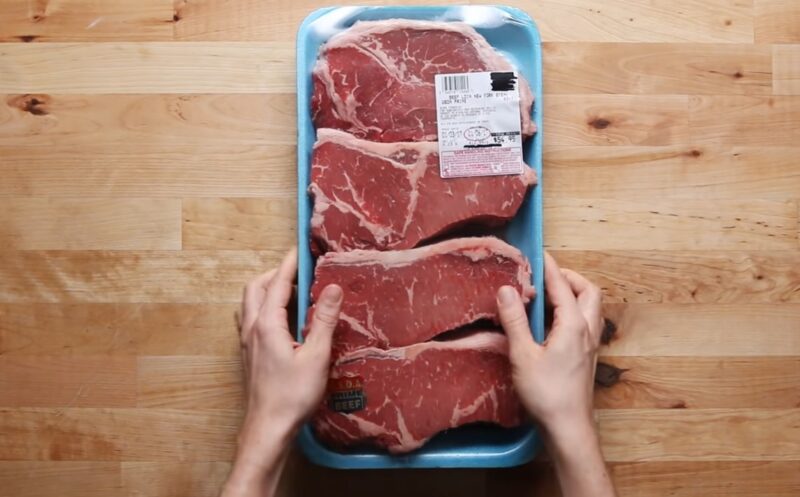
As I contemplate the impact of packaging on steak shelf life, it becomes increasingly clear that the chosen storage method is not a trivial decision. With advancements in packaging technologies, vacuum sealing has positioned itself as a leader in maximizing the freshness of steak stored in the refrigerator. On the other hand, traditional methods like butcher paper or plastic wrap simply cannot compete on the same level when it comes to extending that essential window of freshness.
The science behind the extended shelf life offered by vacuum sealing is tied to its ability to prevent air exposure and moisture loss—two critical factors that contribute to degradation. In comparison, conventional packaging options may leave the steak more vulnerable to spoilage due to their inability to form a complete barrier against external elements. Here, proper sealing is tantamount to preserving not just the taste, but the safety and nutritional value of the steak.
Allow me to elucidate the influences of various packaging options with a well-defined table:
| Packaging Type | Impact on Steak Shelf Life | Protection Against Air Exposure | Moisture Retention |
|---|---|---|---|
| Vacuum Sealed | Highly extends freshness | Excellent | Maintains inherent moisture |
| Butcher Paper | Moderate preservation | Minimal | Variable |
| Plastic Wrap | Moderate preservation | Minimal | Variable |
“In my pursuit for gastronomic perfection, taking advantage of vacuum sealing for steak preservation is not just about prolonging shelf life; it’s about ensuring each cut’s journey from refrigerator to table exemplifies freshness.”
Interestingly, the impact of packaging on steak shelf life is also palpable when examining the nuances of meat spoilage. By shielding the steak from the deleterious effects of oxidation and dehydration, vacuum sealing stands as a bulwark against premature spoilage, thus prioritizing food safety while enhancing consumer satisfaction.
In conclusion, my intimate familiarity with the correlation between packaging and steak shelf life allows me to urge others to consider vacuum sealing as an investment in flavor integrity and longevity. The merits of this method are unmistakable, providing a clear path to elevated culinary experiences for all steak enthusiasts.
Maximizing Freshness ─ Best Practices for Steak Refrigeration
Throughout my culinary practice, I’ve come to appreciate the subtleties involved in maximizing steak freshness. One of the foremost rules I adhere to is ensuring that steaks are refrigerated promptly upon purchase. Immediate refrigeration halts the progression of any microorganisms that might affect the meat’s integrity and flavor profile. Moreover, placing steaks on the bottom shelf of the refrigerator not only follows an orderly storage hierarchy but also serves as a precautionary measure to prevent cross-contamination — one of the cardinal principles of food safety.
An additional step in maximizing freshness involves meticulous attention to how the steak is wrapped. The aim is to create a barrier against external variables that can hasten spoilage. By wrapping the steak tightly before it resides in the fridge, we essentially seal in its quality and ward off the oxygen that could compromise its freshness. My approach to this is grounded in one of the best refrigeration practices — creating an almost airtight enclosure around the food item. This protects the steak notably well until it’s time to bring it to room temperature for cooking.
Crucially, none of this would be effective without the assurance that the refrigerator maintains a steady, cold environment. The USDA advises that meat storage temperatures should be safely kept at or below 40°F, and I’ve learned through experience that this is indeed the threshold that ideally preserves both the safety and the sensory qualities of the steak.
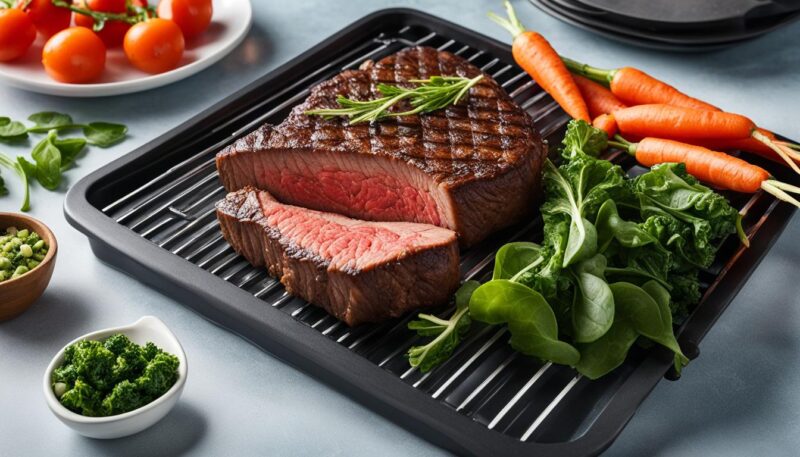
I’ve detailed these best practices into a cohesive table, designed to serve as a quick reference for any cook invested in mastering their refrigeration methods:
| Best Practice | Reason | Benefit |
|---|---|---|
| Refrigerate Immediately | Halts microbial growth | Preserves safety and freshness |
| Bottom Shelf Storage | Prevents fluid cross-contamination | Upholds food safety standards |
| Tight Wrapping | Limits oxygen exposure | Enhances freshness and longevity |
| Temperature Control | Keeps meat below “danger zone” | Maintains quality and safety |
“As a passionate home chef, I’ve come to view the refrigerator not just as a cooling appliance, but as a critical tool in the art of preserving the essence of quality steaks. Implementing these methods positions us not just as cooks, but as guardians of flavor and advocates of food safety.”
These reflections on best refrigeration practices embody more than routine — they represent a commitment to culinary excellence that begins long before the steak reaches the heat of the grill. An unwavering dedication to these principles is the true secret behind savoring a steak that meets every expectation of freshness, tenderness, and taste.
When to Choose the Freezer Over the Fridge
As an enthusiast of culinary preservation, I’ve frequently grappled with the decision of whether to store steaks in the freezer or refrigerator. When planning meals well in advance, or when encountering a bulk sale that cannot be passed up, the freezer offers an ideal long-term storage solution. In these situations, freezing steak is the choice that aligns with forward-thinking meat management. However, this method comes with caveats linked to the gradual decline in steak quality over time.
How Freezing Affects Steak Quality Over Time
An unavoidable truth in the realm of food preservation is that freezing steak can potentially compromise its quality. One of the most common adversaries in this context is freezer burn, a result of moisture loss which in turn can severely deteriorate both texture and flavor of the meat. The cold, arid environment of a freezer can briskly desiccate the unprotected surfaces of a steak. The key here is meticulous packaging, which plays a definitive role in preserving the steak’s inherent qualities and extending its edibility beyond the usual refrigerator period.
“To truly appreciate the value of a well-frozen steak is to understand the pivotal role of proper storage techniques. These methods become the bulwarks that maintain the steak’s integrity during its hibernation in the frosty confines of a freezer.”
Proper Freezing Techniques to Preserve Steak
When it comes to preserving steak quality during freezing, there’s an art to securing the steak’s integrity against the icy elements. The optimal approach entails enveloping the steak in a multi-layered shroud of protection. I advocate starting with plastic wrap, followed by a sturdy layer of aluminum foil, or sealing it within a freezer bag post-vacuum sealing. My method is twofold, creating barriers that resiliently defend against both air and moisture—enemies of a steak’s succulence.
| Packaging Material | Barrier Against Air | Barrier Against Moisture | Recommended for Steak |
|---|---|---|---|
| Plastic Wrap | Base layer | Primary | Yes, as first layer |
| Aluminum Foil | Secondary | Secondary | Yes, as second layer |
| Freezer Bag | Excellent | Excellent | Yes, especially after vacuum sealing |
| Vacuum Seal | Superior | Superior | Highly recommended |
By adhering to these proper freezing techniques, we ensure our steaks stand the test of time, emerging from their arctic slumber as rich in taste and texture as the day they were purchased. These methodologies not only augment the steak’s lifespan but do so while upholding, and sometimes enhancing, the facets that make a steak enjoyable. Embracing these protocols reaffirms my dedication to serving up gourmet experiences undiminished by the passage of time.
Handling Steak Safely ─ From Store to Fridge
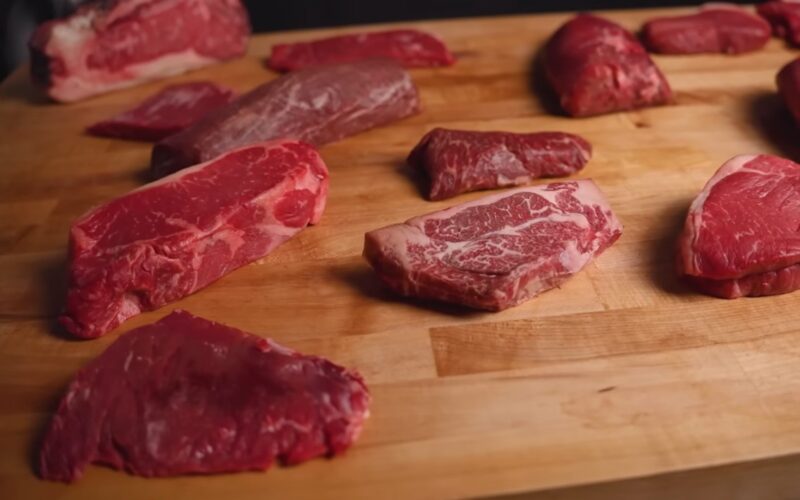
As someone who prioritizes food safety and the importance of handling steak safely, I’ve gathered essential steps every meat-loving individual should integrate into their routine. The journey from store to home fridge is critical, and proper techniques must be employed to ensure safe consumption and preservation of the meat’s quality.
Here’s a key tactic that should never be overlooked: keeping steak cool during transport. This involves a strategic yet straightforward practice of using insulated bags. In my experience, these bags serve as a frontline defense against temperature fluctuations that can push steak into the ‘danger zone‘ – those being temperatures between 40°F and 140°F, where bacteria multiply rapidly.
Upon arrival at home, immediate refrigeration is the cardinal rule I follow for food safety. It’s not merely about convenience; this decisive action is a barrier against bacterial spread, one that holds the line between a fresh cut ready for the grill and a piece of meat that’s in jeopardy. Setting the refrigerator to maintain a steady internal temperature at or below 40°F is also crucial, acting as an unyielding gatekeeper that ensures the steak remains in pristine condition.
To illustrate the importance of these practices, let’s review a comparison of proper versus improper handling methods:
| Handling Technique | Proper Method | Improper Method | Consequences of Improper Method |
|---|---|---|---|
| Keeping Steak Cool | Using Insulated Bags | Leaving Steak Unprotected | Increase in Bacteria Multiplication |
| Refrigeration Timing | Immediate Refrigeration | Delayed Refrigeration | Spoilage and Potential Health Risks |
| Temperature Settings | Refrigerator Below 40°F | Refrigerator Above 40°F | Food Safety Compromised |
“By steadfastly adhering to these handling methods, I ensure that the steak I bring into my kitchen retains its integrity from a food safety perspective, laying the groundwork for a quality meal.”
- Choose insulated bags for transporting steak to maintain a cool environment.
- Refrigerate steak immediately upon home arrival to inhibit bacterial growth.
- Ensure the refrigerator is consistently set at or below 40°F for optimum steak storage.
Recognizing the importance of these steps empowers us to master the art of handling steak safely, transforming every purchase into an assurance of quality and safety. It’s a commitment to excellence that begins even before the steak reaches our kitchens—starting right there in the grocery aisle, where we make decisions that reverberate through every subsequent stage of storage and preparation.
Conclusion
In summing up this comprehensive exploration of steak storage best practices, my reflection on the numerous factors affecting the life of steak in the fridge is punctuated with a commitment to preserving steak freshness and upholding food safety. The guidance provided by the USDA has been a beacon for navigating the complexities associated with safe and effective meat storage
Navigating the intricacies of steak longevity, from raw to cooked, I’ve stressed the profound impact proper packaging and refrigeration settings have on maintaining an exceptional culinary standard. It cannot be overstated how integral it is to employ vacuum sealing when aiming to extend freshness while mitigating the risks of premature spoilage. This, along with consistent adherence to the optimal refrigerator temperature, emboldens my resolve to maintain both the integrity and gustatory delight of the steaks I cherish.
Embracing the sage wisdom to ‘refrigerate immediately’ is tantamount to preserving quality from the moment of purchase. As a stickler for details, meticulously implementing these steak storage best practices has been instrumental in my endeavors to bring to the table an ensemble of safely preserved, flavor-rich steaks. Always remember that by safeguarding your steak’s freshness, you’re honoring the labor and resources invested from pasture to plate, ensuring a safe, satisfying, and sustainable culinary experience.
FAQ
How long does steak last in the fridge?
According to USDA guidelines, raw steak should be stored in the fridge for no more than 3-5 days to ensure freshness and prevent spoilage. Cooked steak can last in the fridge for 3-4 days.
What factors influence the shelf life of steak?
The shelf life of steak is influenced by factors such as refrigerator temperature, packaging, exposure to oxygen, the cut of the steak, its freshness when purchased, and if it has been cooked or raw.
How does temperature affect meat spoilage?
Temperature plays a critical role in meat spoilage. Bacteria that cause spoilage thrive in the “danger zone” between 40°F-140°F. A refrigerator temperature of 40°F or below slows bacterial growth, preserving the steak’s freshness longer.
What are the optimal refrigerator settings for steak storage?
The optimal refrigerator setting for steak storage is at or below 40°F. This slows down bacterial growth and helps maintain the steak’s quality within the recommended timeframe.
What do USDA guidelines say about storing raw steak?
The USDA guidelines recommend storing raw steak in the refrigerator for 3-5 days under optimal conditions at or below 40°F and advise consumers to follow “sell by” and “use by” dates.
Is there a difference in longevity between cooked and raw steak?
Yes, cooked steak tends to have a slightly shorter fridge lifespan of 3-4 days compared to raw steak’s 3-5 days, possibly due to the cooldown process after cooking before refrigeration.
What are the benefits of vacuum sealing steak?
Vacuum sealing steak prevents freezer burn, preserves flavor and texture, and can significantly extend the steak’s freezer life by inhibiting bacterial growth and reducing the risk of spoilage.
How do vacuum sealed steaks compare to those stored in traditional methods?
Vacuum-sealed steaks can last in the fridge up to 10 days, which is notably longer than steaks stored in butcher paper or plastic wrap, typically between 3-5 days. Vacuum sealing also helps retain moisture and reduces exposure to oxygen.
What are the warning signs of spoiled steak?
Spoiled steak may emit an off-odor, like ammonia or rotten eggs, have a slimy texture, and display discoloration. These signs, especially when combined, indicate meat spoilage and that the steak should not be consumed.
How does packaging impact steak shelf life?
The way steak is packaged can significantly impact its shelf life. Vacuum-sealed packaging can extend freshness in the fridge, while conventional packaging offers a shorter window for freshness due to more exposure to air.
What practices help maximize steak freshness in the fridge?
To maximize steak freshness, refrigerate the steak as soon as possible after purchasing, store it on the bottom shelf, ensure it’s wrapped tightly, and keep the refrigerator temperature constant and below 40°F.
When should you freeze steak instead of refrigerating it?
You should freeze steak if you will not be consuming it within the recommended fridge storage times (3-5 days for raw, 3-4 days for cooked). Freezing can preserve steak for much longer periods when done properly.
How does freezing affect steak quality over time?
Freezing can affect the quality of steak if it’s not properly wrapped, leading to freezer burn which dehydrates and damages the steak. Proper wrapping maintains the steak’s moisture, taste, and texture over time.
What are proper freezing techniques to preserve steak?
Proper freezing techniques include wrapping steak in multiple layers of plastic wrap, foil, or placing it in freezer bags after vacuum sealing. These methods protect the steak against air and moisture during extended storage.
How should steak be handled safely from store to fridge?
To handle steak safely, keep it cool, minimize exposure to warm temperatures by using insulated bags during transport, and refrigerate immediately upon arriving home to maintain food safety and prevent bacterial growth.

